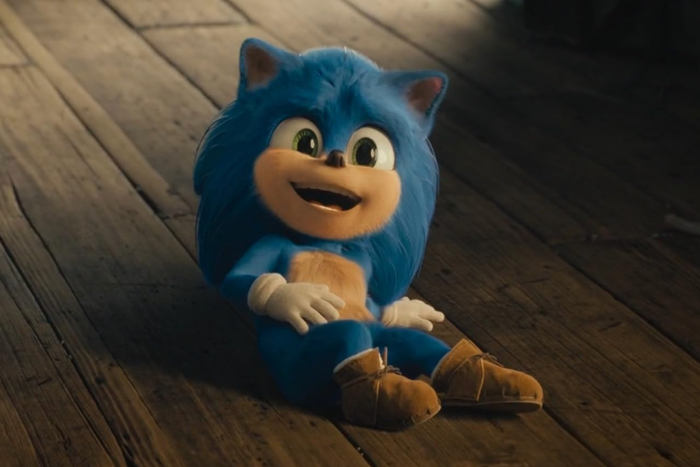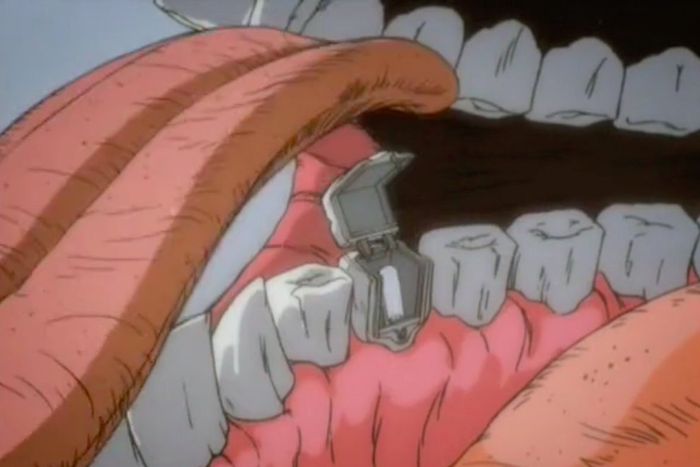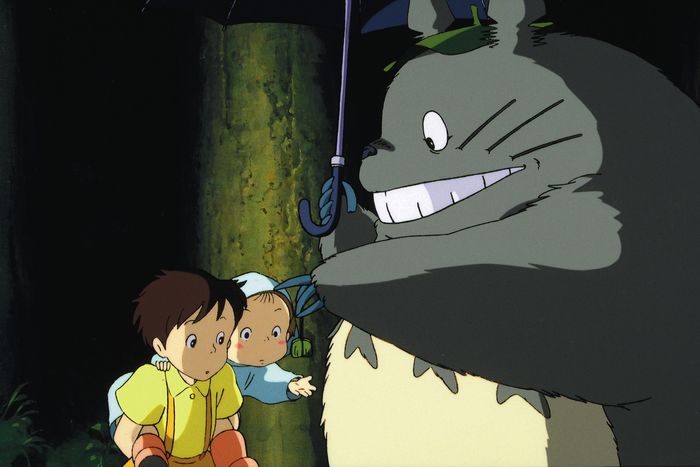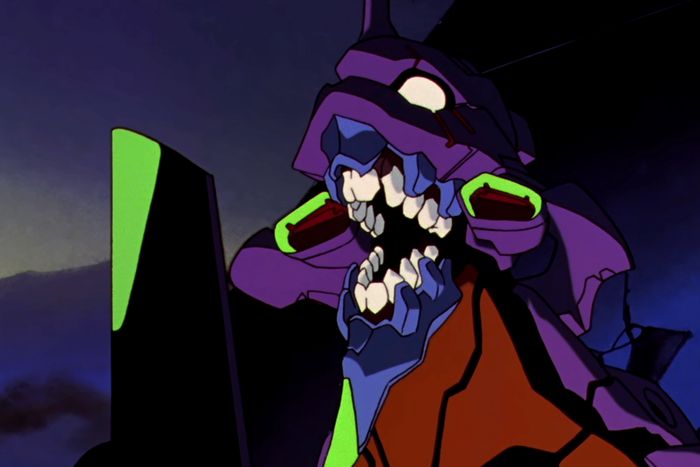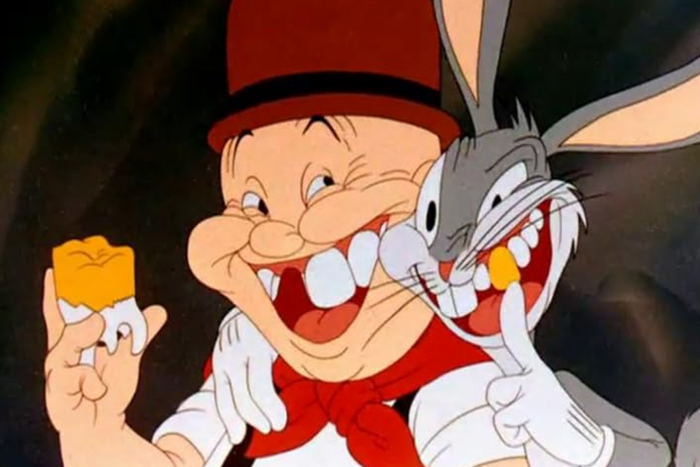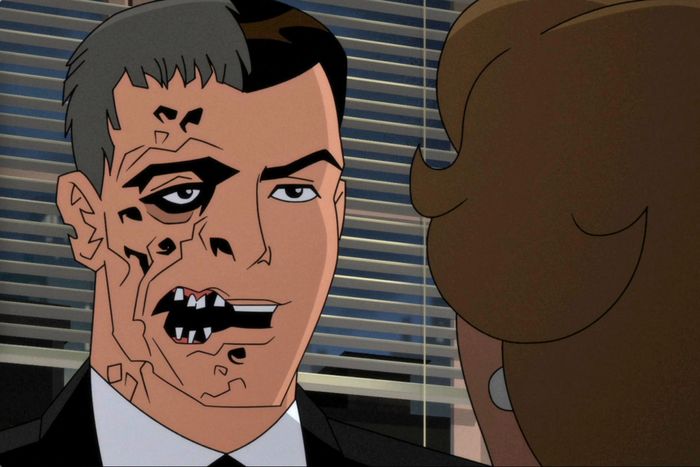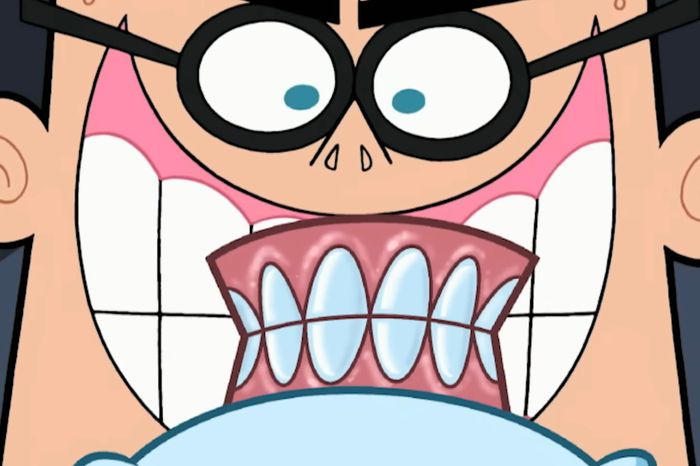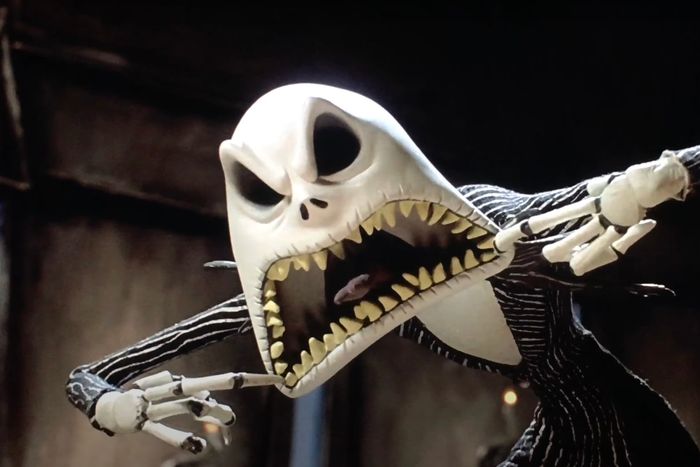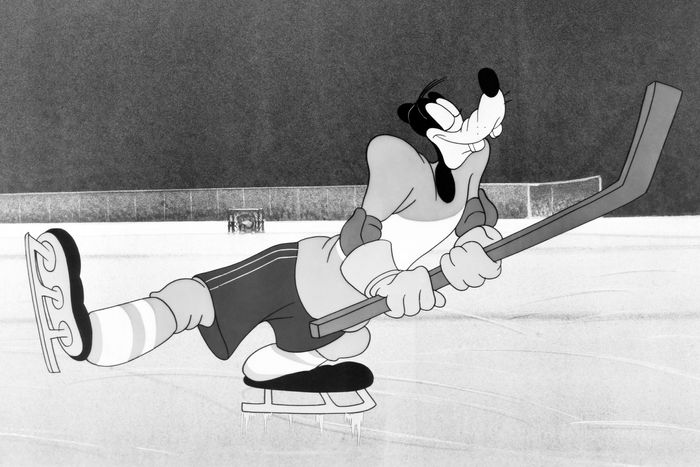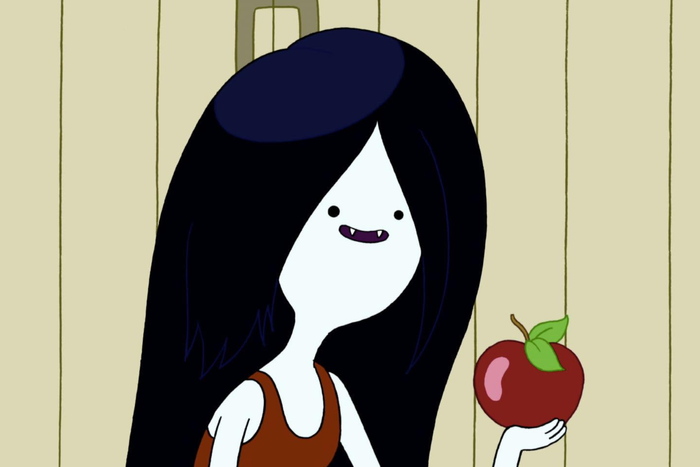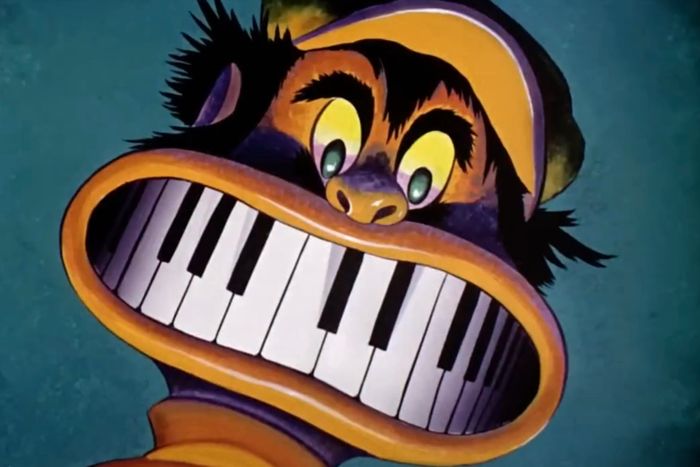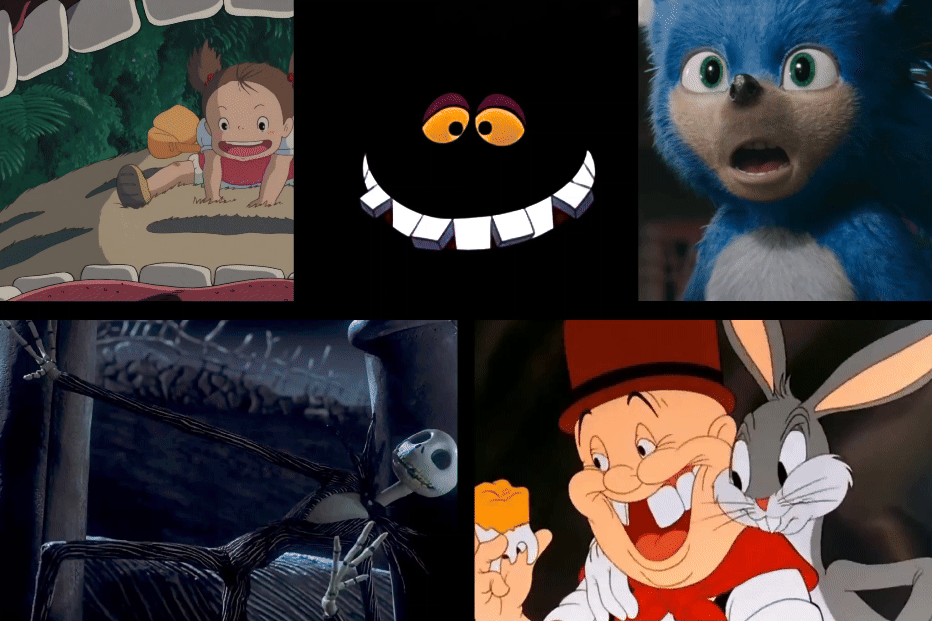
Like all onscreen dentition, animated teeth test our suspension of disbelief: How real do we expect them to look, and how real do they actually look? Designs too lifelike risk reading as too much — eruptions of anatomic linework that invite parody. On the other hand, overly abstract designs can look literally flat and templatized — the same white fill-in bounded by a black line that you’ve seen everywhere. The most important thing in any piece of animation is making sure these mouths chomp and flap legibly and “on-model” at 12 or 24 frames per second.
Anatomically faithful or not, animated teeth can serve as a powerful shorthand for the character itself. Goofy’s two buck teeth are on Disney hats worldwide, while Sonic’s 2020 big-screen teeth drove a fandom to a revolt. They’re just two of the memorable mouths on the spectrum of photorealist-to-surrealist animated teeth that have required massive amounts of attention and care on the parts of animators to get right. Below, brace yourself to revisit a selection of them from animation history, from the ones that look too real to be real to those so twisted they look like, well, not teeth.
Sonic the Hedgehog in Sonic the Hedgehog (2020)
They were so realistic they kicked off the biggest hedgehog scandal of the century, and as a result, the original Sonic movie character design will be studied for years to come. When an early trailer of the much-anticipated video-game adaptation was released and the hero opened his mouth, the people likeliest to pay top dollar for the film went ballistic, forcing the animators to change course and revise the teeth on an already massively expensive blockbuster film. In the final released product and its sequels, the teeth still look eerily human, and the whole episode was the latest lesson — more than 15 years after The Polar Express — that showed that not only are some valleys are still too uncanny to explore but also audiences take teeth designs very, very personally.
Æon Flux and Trevor Goodchild in Æon Flux (1992)
Yes, they match each other’s freak. For the opening seconds of “Gravity,” Æon Flux’s second episode, animator Peter Chung drew his heroine getting frenched and receiving, in a false tooth, a rolled-up piece of paper revealing her mission for the episode. The cartoon, which aired within a five-minute segment of MTV’s Liquid Television, is so short that every frame demands maximum impact. Unlike the stiff action cartoons that dominated ’80s TV, the moving realism of the ’90s here is meticulous: Æon’s and Trevor’s teeth vary in size, sharpness, and curvature; each stands out thanks to individualized shading; and their tongues are unmistakably, erotically fleshy. It’s a lot of work to lay into a few seconds of animation, but it was Chung’s attention to detail and boldness in portraying the risqué that made Æon Flux a ’90s classic.
Totoro in My Neighbor Totoro (1989)
In any other mouth, a set of teeth this large and this defined would be terrifying. Instead, Totoro’s convey not just an anthropomorphic human-ness but also the gentleness that defines his character. In some shots, when he opens wide, counting the bottom row of teeth will reveal that he has the anatomically correct 16 drawn in there (including two obscured by the line of his lower lip) that sport rounded corners and indentations in the molars. Director Hayao Miyazaki has fun with the character’s teeth throughout, comically showing off Totoro’s roar in the scene in the rain at the bus stop then limiting Totoro’s grin in other scenes to a simple triangle. (For an example of scarier Miyazaki teeth, look in the Heron’s beak in The Boy and the Heron.) Miyazaki may be a visionary director, but his best work also showcases his talent as a character designer. Shoutout to the equally delightful grin and fangs of the Catbus, too.
Unit 01 in Neon Genesis Evangelion (1995)
Despite being introduced to the audience as a hulking, humanoid robot, Evangelion Unit 01 is very much alive — an otherworldly cyborg inspired by Japanese folklore’s oni demons and constructed, per their original designer Ikuto Yamashita’s description, as “a giant just barely under the control of mankind.” When the Eva goes berserk, it’s revealed to have gnashing white teeth, a jawline that its armor previously hid and muzzled. It unleashes hell upon its kaiju-sized enemy, the Angel Zeruel, not just defeating the monster but using its teeth to chomp and eviscerate the Angel’s body. Did we mention the main character was in the cockpit of Eva Unit 01 the whole time? Did we mention Eva Unit 01 might also contain the soul of the pilot’s dead mom? The hidden teeth, which quickly stain with the Angel’s blood spatter, serve as a visual metaphor for everything going on under the surface of Neon Genesis Evangelion.
Bugs Bunny and Elmer Fudd in Wacky Wabbit (1942)
For a cartoon about a cute little bunny terrorizing a zhlubby hunter, the teeth that serve as the stinger at the end of Bob Clampett’s Wacky Wabbit look strikingly realistic. The duo show off gold teeth as they break the fourth wall, yes, but like Totoro, the designs follow the human anatomy: visible gums, rounding on the edges, and even defined roots in the one Elmer holds up. Clampett was capable of getting far weirder with teeth (we’ll get there) and known for doing anything to get a laugh out of his characters.
This also happens to be one of the last Bugs Bunny shorts made before another animator in Clampett’s unit, Robert McKimson, refreshed the bunny’s design: raising him a little taller, lengthening his ears, and widening his mouth to accentuate his murine mandibles. In this shot, two years before that redesign debuted in Tortoise Wins By a Hare, he has more teeth than usual, but the two up front remain indelible.
Two-Face in Batman Caped Crusader (2024)
Producer and longtime Batman animation designer Bruce Timm struggled a bit before achieving this update on Two-Face. He was too used to drawing the Batman villain in the style of his other show, Batman: The Animated Series. “He was elegantly ugly in B:TAS,” Timm says. “We wanted him to look really messed-up here.” The tip that made the design click, he says, was a suggestion from his collaborator, James Tucker, to flip the scarred side of Two-Face’s face to the right. Doing that broke Timm out of his old design habit. The resulting design is a new riff on the character that lines up with the show’s ’40s aesthetic — the whole cast, Two-Face included, looks straight out of a pulpy film noir — and reflects the physical and mental scars on the character. His look here also subtly differs in another way from most Batman stories: Two-Face’s scarred teeth are often discolored, but it’s unusual that most of them are missing. “It’s not just grimace-y teeth,” Timm says. “I wanted to make his teeth really damaged by the acid bath he got.”
All the Teeth in “Shiny Teeth” in Fairly Oddparents (2002)
Pop star Chip Skylark has fabulous teeth until they’re stolen (and revealed to be false) by an insane dentist voiced by Gilbert Gottfried in “Shiny Teeth,” one of the best episodes of Fairly Oddparents. It’s not just a knowing indictment of the perfect-teeth industrial complex but a satisfying slander against dentists everywhere — exactly the kind of show you want your kids to watch.
Most, but not at all, of Oddparents’s tooth designs were relatively square; protagonist Timmy Turner stood apart from the pack with his buck teeth. This episode spends a lot of time showing different teeth that aren’t just rectangles but still align with the style and sensibility of the show: singing and dancing molars, the jagged edges of the gums on the evil dentist and his son, the gleaming set of teeth stolen from Skylark, and even teeth as Christmas-tree ornaments. Fairly Oddparents creator, director, and songwriter Butch Hartman has said the episode’s musical number, “My Shiny Teeth and Me,” went on to become one of the show’s most popular songs.
Jack Skellington, The Nightmare Before Christmas (1993)
Teeth tend to break down under prolonged abuse, just like the materials used to make stop-motion models. To create Jack Skellington for The Nightmare Before Christmas, sculptors Shelley Daniels and Randy Dutra had to craft, by hand, nearly 800 different heads to match designs by story artist Jorgen Klubien. That meant a lot of teeth for a character who sings, screams, and yawns over the course of the classic film. Jack also has a couple layers to his mouth — an outer layer of drawn-on lines and an inner row of teeth, which sometimes appear and sometimes don’t. When he roars, they get pointy (you know, just like ours).
Goofy in Hockey Homicide (1945)
They may be the most prominent pair of central incisors in animation history. Hockey Homicide, directed by Jack Kinney, came out during something of a transition period for the Goofy shorts, which at the time would use a base Goofy model for several different characters, some with the teeth and others without. In this one, the Goofs are at a hockey game — some as players, some as spectators, and the more buttoned-up Goofs don’t sport the teeth. Over the course of the seven-minute short, the hockey game builds in intensity and the announcer rattles off plays faster and faster, with sticks and pucks flying everywhere and the audience joining in on the pandemonium. (At one point, in a non sequitur cut, Monstro, the whale from Pinocchio who has rows of sharp teeth instead of truer-to-life baleen hair, makes a cameo.) The teeth serve as one of the central, obvious visual cues that the whole world has gone Goofy: By the end, every character onscreen is proudly displaying their protruding teeth as they get into the fun of the game.
In the late ’40s, Disney began rolling out a Goofy Everyman series that strove to clean him up, erase his dental protrusions, relegate his teeth to rectangular boxes, and dress him in business clothes, but the redesign just didn’t stick and maybe even read as a little evil. As Art Babbitt, the Disney Old Man most responsible for developing his iconic design, once wrote in a 1,046-word analysis of the character, “buck teeth” are part of the appeal.
Marceline in Adventure Time (2010)
With her two little fangs visible in a closed smile, this vampire queen looks less like the traditional idea of a vampire than she does a girl with yaeba, the somewhat fashionable snaggle-toothed look known in Japan. Her design and transformative power evolved throughout Adventure Time, varying slightly in size, outfits, and form depending on which artists drew her over the course of the show’s decade-long run. But from the original series pitch document that creator Pendleton Ward produced to the finale, those eyeteeth stayed cute, small, and inviting — until the moments like the shot in “Henchmen” (and many other episodes) when they widened into the monstrous form she usually kept hidden. Marceline’s tiny teeth are the tips of the iceberg, the key to understanding her tragic, romantic, undead existence.
The Cheshire Cat in Alice in Wonderland (1951)
The teeth are the first visual hints you get of the Cheshire Cat, a trickster who spews nonsense cribbed from Lewis Carroll’s “Jabberwocky” poem. Designed and animated by the jazz trombonist and Disney cartooning stalwart Ward Kimball, the teeth illustrate both the Cat’s playfulness and magical prowess. At first they move less like teeth than they do accordion-key slats, testing notes alongside the movements of his mouth before the Cat appears in full and begins to talk to Alice in earnest, his teeth lining up into a wide, unabating grin. Their design is simple but unsettling; they’re recognizably teeth but, strangely, more because of how they move and how they’re introduced. (Disney’s 2010 remake, which gives him a row of gruesome cuspids, utterly fails to capture the Cat’s enigmatic nature.) The teeth visually represent the Cat’s musical, poetic nature, only barely getting in order once he figures out what tune he’s going to play for the lost Alice. And it’s hard to say for certain, but the Cat may or may not have been influenced by our last entry on this list.
88 Teeth, The Great Piggy Bank Robbery (1946)
Unknowable by nature, the villainous cadre that Daffy Duck stumbles upon in Bob Clampett’s Bank Robbery is among the funniest single-frame jokes of the Looney Tunes canon. Snake-Eyes has dice where his eyeballs should be, Hammerhead’s head is shaped like a hammer, and 88 Teeth, well, he’s got piano keys for pearly whites. 88 Teeth, like most of his gang, is ultimately gunned down in a hail of bullets — a violent end for the villains of what would be one of Clampett’s last cartoons before leaving Warner Bros.
As a whole, it’s a surrealist triumph achieved in part by the painted frames of characters like 88, and its plot — in which Daffy is sucked into a comic-art nightmare (at one point he gets erased by another villain with a pencil for a head) — is not unlike the one Clampett’s rival Chuck Jones would throw Daffy into in his own short Duck Amuck, released seven years later. On his way out, Clampett left a few other cartoons for his fellow animators to finish, but The Great Piggy Bank Robbery feels like his parting note. And unlike the other teeth on this list, 88’s are revealed in not a moving image but a cutaway shot. They don’t move, but they still have bite.
More From This Series
- Drilling Into the Painful Cavities of Celebrity ToothTok
- The Case of Jack Nicholson’s Missing Baby Teeth
- My Favorite Teeth
- Jim Carrey Is the World’s Greatest Teeth Actor



